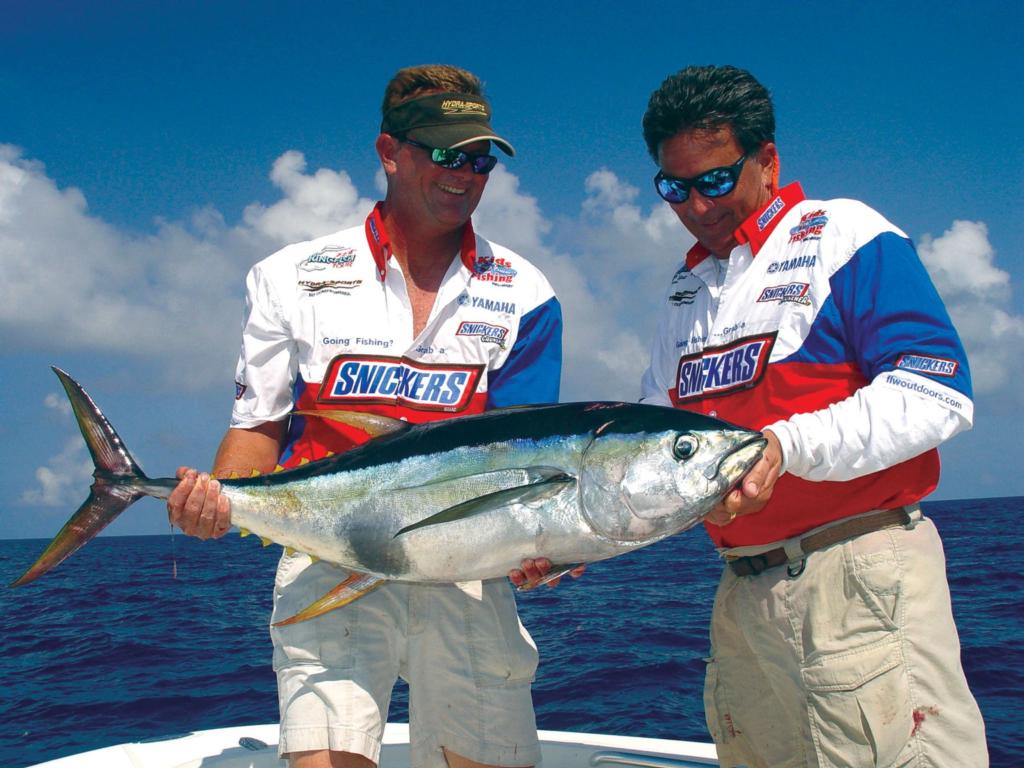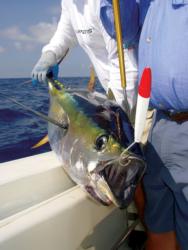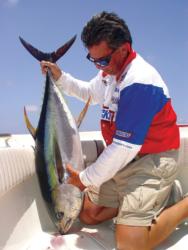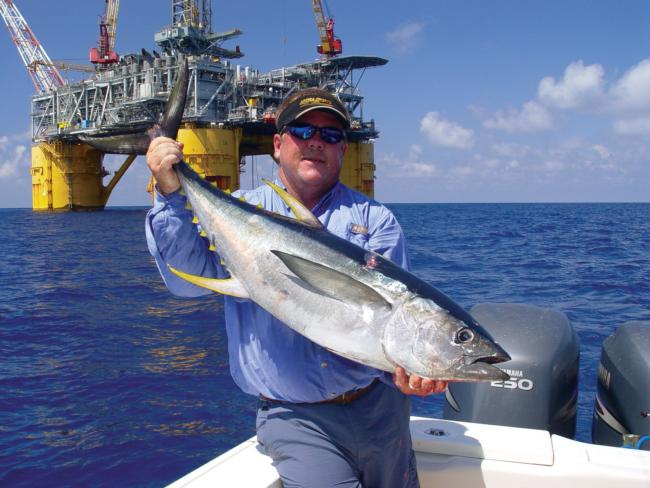Mission to Mars: Yellowfin tuna
An offshore drilling rig provides outstanding big-game action

For decades, the entertainment industry has told us a trip to Mars will turn up little green men. Well, in the northern Gulf of Mexico, a trip to Mars yields a close encounter with the big yellow guys.
Yellow as in yellowfin tuna. As in back-breaking, arm-stretching brutes. As in succulent fillets worth every ounce of pain and suffering.
The Mars oil platform sits in approximately 3,000 feet of warm, blue water, where strong Gulf upwellings keep the massive structure washed with nutrients and microscopic life forms that create the foundation for an entire ecosystem of progressively larger food-chain links.
Ranking below only billfish and monstrous Gulf sharks, yellowfin are definitely the big shots of the rig. Stocky, muscular missiles, these fish will test your resolve as well as your tackle. If you’re used to finessing kingfish on light drags, you need to learn a new game. It’s like comparing soccer to rugby. Tuna take it tough, and they’ll make you pay dearly for every inch of line.
“These fish are unbelievably powerful,” said kingfish pro Alex Leva of Tampa, Fla. “They’ll give you all you want.”
Leva has been journeying to southern Louisiana for the last dozen years. Although kingfish tournaments have often been his primary focus, he also likes to make time to shed the pressures of competitive fishing and just enjoy the Gulf’s many charms.
“It’s nice to get out here and spend time fishing with friends chasing these fish,” Leva said.
About seven miles to the southeast of Mars, another massive rig named Ursa offers similar structure and current dynamics. Proximity allows you to easily bounce between the two if tuna play hard-to-get.
Unlike nearshore fishing, where game fish orientate to wrecks, reefs and ledges, bluewater fishing can be more of a cat-and-mouse game. Although the briny buffet of various forage species found beneath a rig’s superstructure attracts the yellow bullies, tuna personify the phrase “high strung.” They simply won’t sit still.
“There’s no GPS number to run to – this is pure hunting,” Leva said. “You have to have your eyes open and looking around. When these fish are in several thousand feet of water, they’re not hanging over anything. They’re just following the bait schools and the thermals.”
 Indeed, patches of warmer water definitely appeal to these fish, but nothing attracts tuna like a bustling school of baitfish. In the northern Gulf, threadfin herring, menhaden and ballyhoo will work, however, when you talk about tuna candy, you’re talking blue runners, but not the 2-pound jumbos trolled for kingfish. Yellowfin favor the hand-sized juvenile runners found schooling near rigs, as well as beneath weed lines and Gulf flotsam.
Indeed, patches of warmer water definitely appeal to these fish, but nothing attracts tuna like a bustling school of baitfish. In the northern Gulf, threadfin herring, menhaden and ballyhoo will work, however, when you talk about tuna candy, you’re talking blue runners, but not the 2-pound jumbos trolled for kingfish. Yellowfin favor the hand-sized juvenile runners found schooling near rigs, as well as beneath weed lines and Gulf flotsam.
Yellowfin are a gluttonous lot that roam the ocean in search of their next meal. When a pack locates a school of baitfish, the surface erupts with white-water slashing, frothy boils and showering baitfish. Nothing short of spectacular, a motivated yellowfin will hit a topside meal at such velocity that his momentum carries him on a 10-foot skyward arc before crashing back into the sea.
“The locals call it `footballs in the air,'” Leva said. “Seeing a 100-pound yellowfin free jumping is pretty impressive.”
As aggressive as they may be, tuna spook easily and plowing a spread of baits through them will put the school down for a long time. The best bet is to watch the commotion for a minute or so to determine a course or general area of concentration. Baitfish will run, and predators will follow, so line up an interception point and then drift into the fish.
Leva’s teammates, Allen Winchel of Stuart, Fla., and Troy Nelson of Loxahatchee, Fla., know that kiting live baits can enhance a drift spread by teasing tuna into investigating the struggles of a blue runner dangling just below the surface.
With any presentation, Leva’s helmsman, Jim Ladner, of Gibsonton, Fla., stays at least 50 yards off the rig to avoid the marauding barracuda that patrol near the structure. Even with such prudence, if his baits make it through these ravaging pests, Ladner knows that a hooked fish can become a target for the toothy freeloaders.
When fish are scattered, or if they have yet to locate them, Leva’s crew trolls a mix of deep-diving lures like the Yo-Zuri Bonita, surface runners and the old tried-and-true cedar plug. The latter –  comprising a cigar-shaped wooden tube with metal ends and a dangling hook – resembles a fleeing baitfish. Winchel says a traditional brown or red-white cedar plug run behind a daisy chain squid teaser makes an irresistible combination.
comprising a cigar-shaped wooden tube with metal ends and a dangling hook – resembles a fleeing baitfish. Winchel says a traditional brown or red-white cedar plug run behind a daisy chain squid teaser makes an irresistible combination.
Ladner’s trolling speeds average about 3 to 5 knots and tuna have no trouble catching their meals at this pace. Making broad hooks around the school allows him to pull baits through the fish without passing overhead with the boat.
Winchel advised keeping all lines in the water for a couple of minutes after a tuna hookup, and you’ll have a good chance of scoring double or triple headers. Between bites, Winchel checks baits frequently, as floating grass and debris will mar presentations.
If the action slows, you can often jumpstart a bite by chumming with thumb-sized chunks of frozen baitfish or baitfish that die in the livewell. Tuna aren’t picky, so lay out a generous trail of freebies and get ready for a strike.
On a recent outing, Winchel’s chum job not only sparked a new round of yellowfin bites, but it also congregated a pod of dolphin. The juvenile “chickens” always show up first, but within a few minutes, a couple of 20-pounders rushed in for a sampling.
For dolphin and other targets of opportunity, keep a heavy-action spinning outfit rigged with a fluorocarbon leader and a 7/0 live-bait hook. When a fish comes to investigate, pitch a live blue runner or a freshly cut chunk their way, and the sudden meal is usually met with instant acceptance. If deck space permits, keep a live bait hooked and held in a bucket of water for faster presentations.
An important, yet often overlooked element of tuna fishing is tending to your catch. “Most people think that all you have to do is cut the tuna’s throat to bleed it,” Leva notes. “But if you want to keep that meat in top condition, you have to remove the gills and the internal organs. Then you pack the body cavity with ice and cover the fish with a layer of ice.”
 Federal law prohibits recreational vessels from transporting filleted fish over water, so keep the rest of the fish intact.
Federal law prohibits recreational vessels from transporting filleted fish over water, so keep the rest of the fish intact.
The best part of long-range tuna fishing is that the fillets you’ll bring home will more than satisfy the appetite you’ll work up during the trip.
Opportunistic angling
Flotsam such as logs, matted vegetation, coolers and tangles of rope offer shade and shelter for baitfish in open water. When you spot such objects, running baits or lures around their perimeters is a good bet for connecting with tuna, wahoo and dolphin that instinctively inspect all possible feeding stations.
Even if you locate no predators, anything found floating in bluewater has been there for several hours or more, so the likelihood of baitfish concentration around it is high. That said, anglers can maximize this opportunity by attaching a rope or heavy monofilament to the flotsam and cleating it off. By keeping the pelagic food court next to your boat, you give predators a reason to venture close.
This proximity also enables you to harvest some of the offshore baits hiding beneath the object and immediately put them into service. Jiggle a gold-hooked sabiki rig in the shadows and you’ll often pull up colorful rainbow runners and blue runners – both excellent offshore baits.
Obviously, this strategy dilutes during high-speed trolling, but for drifting or slow-trolling, it works like a charm. Be mindful, though, of the object’s position to avoid tangling while fighting fish or deploying baits. If you decide to move to another spot, simply detach your connecting line and leave the flotsam for another boat.